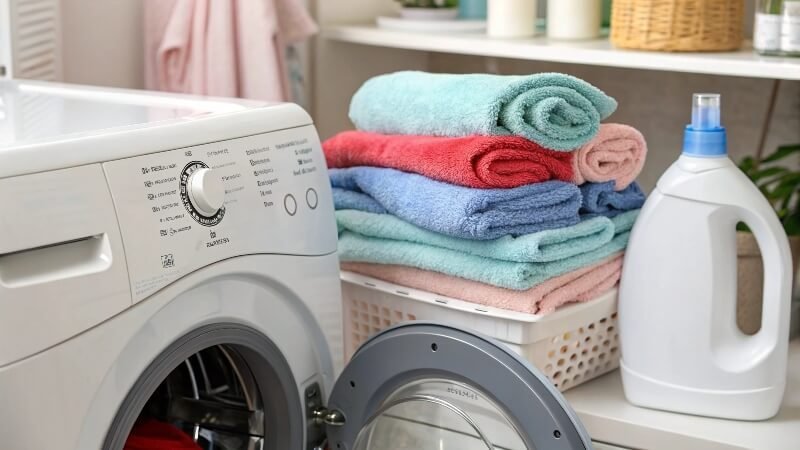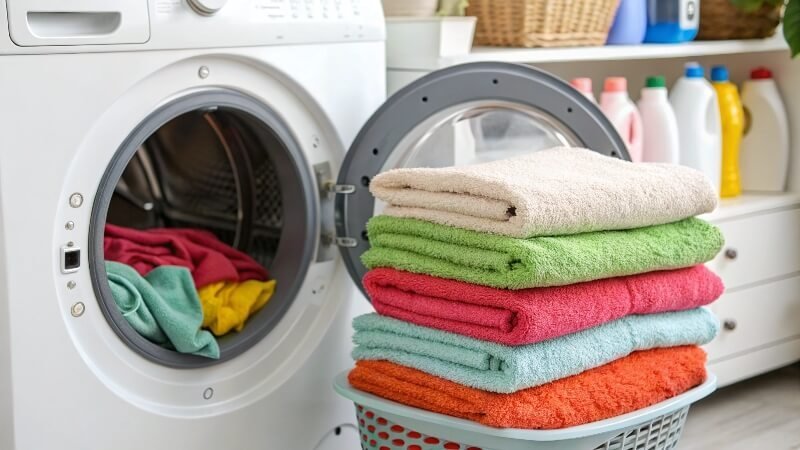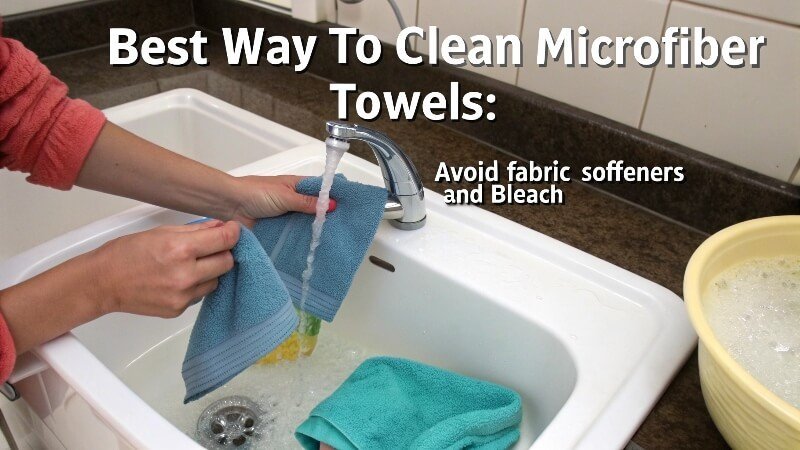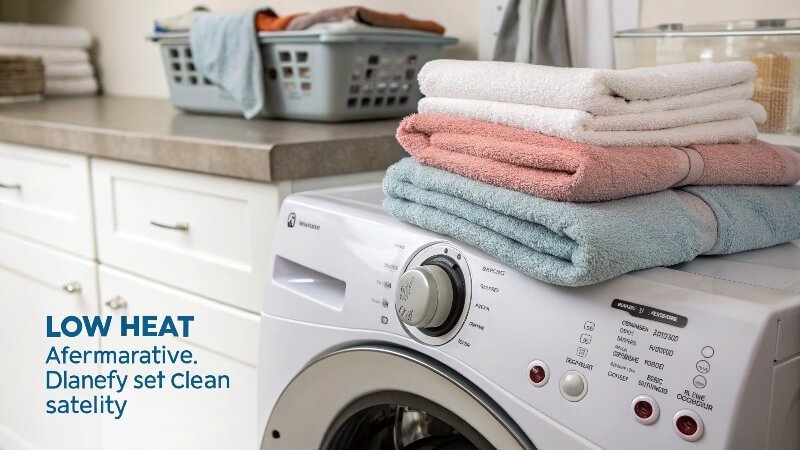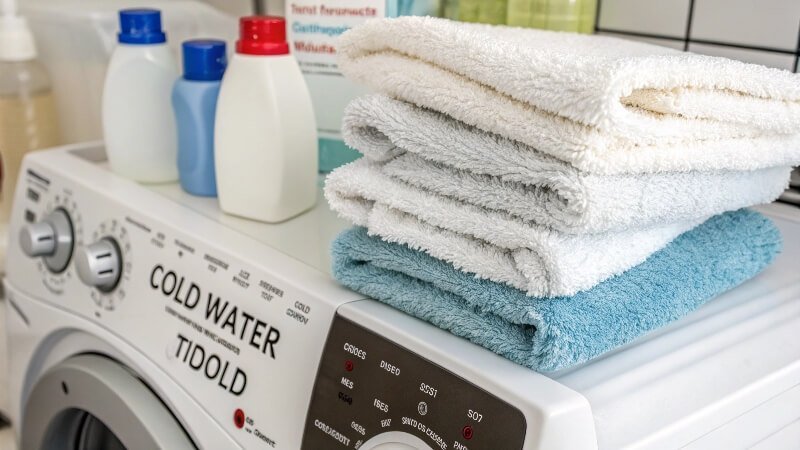Are your microfiber towels losing their magic? They feel stiff and don’t absorb like they used to. Here’s how to restore them with a simple wash.
The best way to wash microfiber towels is to use a gentle liquid detergent, wash them separately from other fabrics in warm water, and avoid fabric softeners and high heat. This simple process keeps their unique fibers absorbent and soft for longer.
Keeping your microfiber towels in top shape is easier than you think. It’s all about avoiding a few common mistakes that can ruin their special fibers. In my years in the textile industry, I’ve seen so many businesses struggle with this, but once you know the right steps, your towels will perform perfectly for years. Let’s break down exactly what you need to do, step-by-step.
Can you put microfiber towels in a washing machine?
Worried about ruining your microfiber towels in the wash? Tossing them in with everything else can clog their fibers and make them useless. Here’s the right way to do it safely.
Absolutely. Machine washing is the most effective way to clean them. Just be sure to wash them only with other microfiber items. This stops lint from other fabrics, like cotton, from sticking to the fibers and reducing their cleaning power.
Using a washing machine is the best way to get deep-seated dirt out of your towels. The key is to protect the very fibers that make them so effective. Microfiber works because it has a static charge that attracts and traps dust, dirt, and lint. When you wash it with other materials, especially natural fibers like cotton or terry cloth, it does its job too well. It pulls all the loose lint from those items and holds onto it, which clogs the microfiber and makes it less absorbent. I once had a hotel client complain their new towels weren’t working. It turned out they were washing them with their cotton bathrobes. Once they separated the laundry, the problem disappeared.
Best Practices for Machine Washing
To get the best results, you need to set up your wash correctly. It’s not just about what you put in, but also how you wash it.
| Do | Don’t |
|---|---|
| Wash only with other microfiber. | Mix with cotton or other fabrics. |
| Use a gentle or delicate cycle. | Use a heavy-duty or aggressive cycle. |
| Use a laundry bag for extra protection. | Overload the machine. |
Using a mesh laundry bag is a great pro-tip, especially for smaller or more delicate microfiber items. It adds another layer of protection and ensures they don’t get snagged or overly stretched during the spin cycle. This small step can significantly extend the life of your investment.
What is the best way to clean microfiber towels?
Are your cleaning methods making your towels worse? Using the wrong soap can leave a residue that blocks absorbency. Discover the best way to get them truly clean.
The best method is to use a specialized microfiber detergent or a gentle, dye-free liquid detergent. Use only a small amount. Avoid fabric softeners and bleach, as they clog the fibers and damage the material, making the towels useless.
The cleaning agent you choose is the most critical factor after separating your towels. Microfiber is made of polyester and polyamide, which are essentially forms of plastic. Harsh chemicals and additives can ruin them instantly. Fabric softener is the number one enemy. It works by coating fibers with a waxy, lubricating film to make them feel soft. On microfiber, this film completely clogs the microscopic pores, destroying the towel’s ability to absorb water and pick up dirt. Bleach is just as bad, as it can break down the polyamide fibers, making the towel brittle and weak. I always advise our clients to stick to the basics. A simple, clean-rinsing detergent is all you need.
Cleaning Agent Showdown: What to Use and What to Avoid
Think of it this way: you want to clean the fibers, not coat them.
| Cleaning Agent | Why It Works (or Doesn’t) | Recommendation |
|---|---|---|
| Microfiber Detergent | Specially formulated to rinse clean and break down heavy soils without residue. | Best Choice |
| Gentle Liquid Detergent | Free of dyes, perfumes, and softeners. Rinses cleanly. | Good Alternative |
| White Vinegar | Can be added to the rinse cycle to strip away old residue and soften towels naturally. | Use Sparingly |
| Fabric Softener | Coats and clogs the fibers, destroying absorbency and cleaning power. | Avoid Completely |
| Bleach | Degrades the polyamide fibers, making the towel weak and ineffective. | Avoid Completely |
| Powder Detergent | Can leave undissolved granules trapped in the fibers. | Use Liquid Instead |
If your towels start to feel stiff, a great trick is to wash them with about half a cup of distilled white vinegar and no detergent. The vinegar helps dissolve any mineral or detergent buildup and can restore a lot of the towel’s original softness and absorbency.
Can I put microfiber towels in the dryer?
Afraid the dryer will melt your microfiber towels? High heat is their biggest enemy, turning them stiff and useless. Here’s how to dry them without any damage at all.
Yes, you can use a dryer, but only on a low-heat or no-heat tumble dry setting. High heat will melt the delicate fibers, making the towels hard and ineffective. Air drying is always the safest and best option if possible.
Heat is the fastest way to destroy a microfiber towel. Remember, the material is a type of plastic. When exposed to high temperatures in a dryer, the tiny, delicate fibers can melt, fuse together, and become hard. We call this "heat glazing." A glazed towel loses all its softness and can even scratch surfaces. I’ve seen this happen with towels used by car detailers who were in a hurry. They’d throw them in a hot dryer, and a premium $10 towel would be ruined in a single cycle. To avoid this, always check your dryer settings. Low heat or an air-fluff cycle is the only safe way to machine dry.
Drying Methods: Pros and Cons
The best method depends on how much time you have and how cautious you want to be.
| Drying Method | Pros | Cons |
|---|---|---|
| Air Drying | – Safest method, zero risk of heat damage. – Energy-efficient and free. – Maximizes towel lifespan. | – Takes longer. – Can feel slightly stiff if not fluffed. |
| Low-Heat Tumble Dry | – Fast and convenient. – Helps fluff the fibers and maintain softness. | – Risk of damage if heat is accidentally too high. – Uses energy. |
| No-Heat Tumble Dry | – Very safe, no risk of melting. – Fluffs the fibers better than air drying. | – Slower than low-heat drying. – Not all dryers have this setting. |
If you choose to machine dry, throw in a few wool dryer balls. They bounce around, separating the towels and helping them dry faster and feel softer. Most importantly, they do this without the chemicals found in dryer sheets, which, like fabric softener, will clog the microfiber’s pores.
Do I wash microfiber towels in hot or cold water?
Does hot water clean better, or does it harm your towels? Using the wrong water temperature can either fail to clean your towels or permanently damage their fibers. Let’s clear it up.
Always wash microfiber towels in cold or warm water, never hot. Hot water can damage the fibers, similar to high heat in a dryer. Warm water is effective enough to release dirt and grime without harming the material’s structure.
The right water temperature strikes a balance between effective cleaning and fiber preservation. Just like with the dryer, excessive heat from the washing machine can cause the plastic-based fibers to deform or slightly melt. While not as dramatic as a hot dryer, repeated washing in hot water will shorten the towel’s lifespan and reduce its performance over time. Warm water is the sweet spot. It’s warm enough to help loosen oils, grease, and stubborn dirt from the fibers, allowing the detergent to work effectively. Cold water is the gentlest option and is perfect for lightly soiled towels or for those looking to be as energy-efficient as possible.
Water Temperature vs. Cleaning Effectiveness
Choosing the right temperature depends on how dirty your towels are.
| Water Temperature | Best For | Impact on Fibers |
|---|---|---|
| Cold (Below 30°C / 86°F) | Lightly soiled towels (e.g., dusting, glass cleaning). Maximum energy savings. | Most gentle. Best for preserving fibers for the longest possible time. |
| Warm (30-40°C / 86-104°F) | Moderately to heavily soiled towels (e.g., mopping, auto detailing, kitchen spills). | The ideal balance. Effectively cleans without causing significant damage. |
| Hot (Above 40°C / 104°F) | Not recommended for microfiber. | High risk of permanent damage. Can cause fibers to melt, stiffen, and lose effectiveness. |
For most of our business clients, from hotels to cleaning services, I recommend a standard wash in warm water. It provides consistent, reliable cleaning for all kinds of messes without putting the towel inventory at risk. For general home use, where towels might not be as heavily soiled, washing in cold water is a fantastic and safe choice.
Conclusion
Wash microfiber separately in warm water with a gentle detergent. Avoid fabric softeners and high heat. This simple routine keeps your towels working like new for years.

